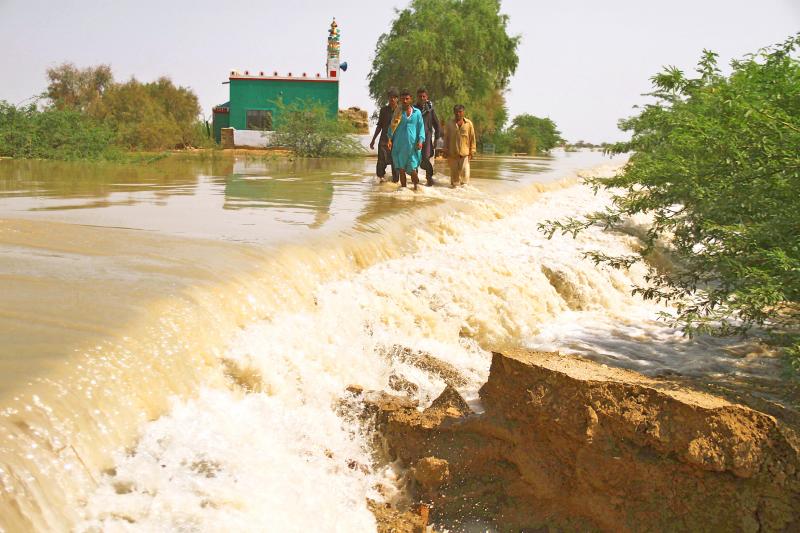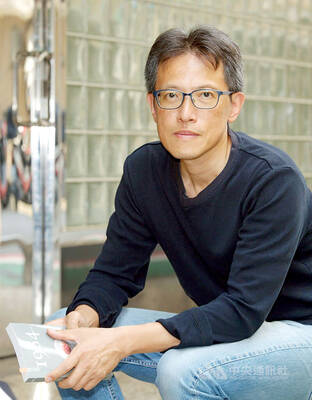Craftsman Mohammad Zakir, 35, who lives in a low-lying area of Karachi’s Orangi Town, does not recall the authorities ever cleaning out the stormwater drain serving his neighborhood.
Thorani Goth in West District was flooded during the fourth bout of monsoon rain this season from Aug. 6-8.
During that — and a previous downpour late last month — water came up 1.2-1.5m inside Zakir’s home, ruining furniture, electrical equipment and important documents.

Photo: EPA-EFE
It also soaked an order of 250 women’s garments he was due to decorate with sequins and beads — his first job in five months due to the coronavirus pandemic.
“I’ll put them out to dry to see if there are water stains on them,” said the informal-sector worker.
If the clothes were ruined, he would have to bear half the cost of 250,000 Pakistani rupees (US$1,488), he added.

Photo: AP
Karachi Mayor Waseem Akhtar said people “are certainly not exaggerating when they say water comes up chest-high into their homes.”
The city has a network of 550 stormwater drains which zig-zag through the city and flow out into the Arabian Sea, but many are obstructed by illegal construction, waste and sludge.
Akhtar said the city authorities cleaned out the drains every year before the monsoon, except last year when the provincial government did not provide the funds for the work.
In the mayor’s four-year term, which ends this month, management of Karachi’s services have been hamstrung by disputes between different levels of government.
Meanwhile the city’s infrastructure is struggling to cope with heavy monsoon rains, as seen this year.
Sardar Sarfaraz, Karachi head of the Pakistan Meteorological Department, said rainfall of as little as 50mm could cause urban flooding in some of Karachi’s low-lying areas, with the most recent downpour easily exceeding that across the city.
Scientists are still figuring out how global warming will affect the Asian monsoon, but in many parts of the world, higher temperatures are fueling more intense bouts of rainfall.
Sarfaraz noted the trend is for more erratic weather patterns, as predicted by climate scientists.
In Karachi, the August rains killed 22 people, 11 of them by electrocution, after 10 died in July. From 2014 to last year, the city recorded more than 70 rain-related deaths, with 2018 an exception as it was largely dry.
After the havoc last month — with main roads submerged, sewage spewing from manholes and into homes, and power cuts lasting for hours — Prime Minister Imran Khan tasked the National Disaster Management Authority (NDMA) with sorting out the city’s drains.
The NDMA, helped by the military’s engineering wing, said it had cleaned three major drains in just under a week, clearing 42 choke points and removing more than 31,000 tonnes of sludge.
After touring the city, Sindh Information Minister Syed Nasir Hussain Shah told Pakistan’s Dawn newspaper there were no floods in the city, despite the intensity of this month’s rain, as prevention policies had been effectively implemented.
But Zakir’s experience does not back up that assertion.
ILLEGAL BUILDING
Hot sun after the monsoon rain has provided some respite for Zakir’s family and the 13 million city residents, out of a population of more than 17 million, who live in informal settlements that are prone to flooding.
Zakir blamed illegal construction along the drainage channels, adding that “the government needs to come here and bulldoze” the buildings.
“The stormwater drains, some as wide as 200 feet, have over the years, due to unauthorized construction, narrowed to just 30 feet — so what do you expect?” said Mayor Akhtar.
The main responsibility lies both with residents who have encroached on land along the drain, and the provincial government for letting it happen, said the outgoing mayor.
The province of Sindh has taken a larger share of control from the city authority but has not provided the budget owed, which a court ruling ordered it to pay, Akhtar said.
A Sindh government spokesman said it did not owe money to the Karachi Metropolitan Corporation, to which it had transferred 50 billion rupees in the last three and a half years.
Solid waste dumped into stormwater drains exacerbates the flooding. It is estimated that the mega-city generates 13,000 tonnes of garbage daily.
The Sindh Solid Waste Management Board collects 70 percent of that and takes it to two landfills, but told the Thomson Reuters Foundation it does not know what happens to the rest.
Sewage is also being dumped in storm drains, as little has been invested in rehabilitating the crumbling sewerage system for two decades despite the city’s expansion, officials said.
LONGER-TERM PLAN?
Zubair Channa, director of the Sindh government-led Solid Waste Emergency and Efficiency Project (SWEEP), funded with $100 million from the World Bank, said encroachment on most of Karachi’s large drains over a long period, coupled with their uneven width, caused disturbances in the flow of water.
Drains feeding into the big water channels are also not well maintained, making the flooding worse, noted the civil engineer.
“What is needed is a comprehensive engineering solution,” he said, rather than “firefighting” each year as the city does now.
In its first year, the SWEEP project has hired contractors to remove about 10 million cubic feet of sludge from the drains and deposit it in landfill by the end of August, he noted.
With floods causing so much devastation year after year, Mayor Akhtar said it was time “to take the firm but unpleasant decision” of pulling down illegal buildings.
Before that is done, people must be provided with an alternative, he added.
“There is enough government land that can be used for both vertical expansion as well as developing satellite towns around Karachi, where these people can be shifted,” he said.
But with Karachi run by three tiers of government dominated by three different political parties, real solutions to its problems are often lost in a war of words.
“We need the judiciary and the army to sit with experts like architects and town planners to resolve the issue,” Akhtar said.

Three big changes have transformed the landscape of Taiwan’s local patronage factions: Increasing Democratic Progressive Party (DPP) involvement, rising new factions and the Chinese Nationalist Party’s (KMT) significantly weakened control. GREEN FACTIONS It is said that “south of the Zhuoshui River (濁水溪), there is no blue-green divide,” meaning that from Yunlin County south there is no difference between KMT and DPP politicians. This is not always true, but there is more than a grain of truth to it. Traditionally, DPP factions are viewed as national entities, with their primary function to secure plum positions in the party and government. This is not unusual

Mongolian influencer Anudari Daarya looks effortlessly glamorous and carefree in her social media posts — but the classically trained pianist’s road to acceptance as a transgender artist has been anything but easy. She is one of a growing number of Mongolian LGBTQ youth challenging stereotypes and fighting for acceptance through media representation in the socially conservative country. LGBTQ Mongolians often hide their identities from their employers and colleagues for fear of discrimination, with a survey by the non-profit LGBT Centre Mongolia showing that only 20 percent of people felt comfortable coming out at work. Daarya, 25, said she has faced discrimination since she

More than 75 years after the publication of Nineteen Eighty-Four, the Orwellian phrase “Big Brother is watching you” has become so familiar to most of the Taiwanese public that even those who haven’t read the novel recognize it. That phrase has now been given a new look by amateur translator Tsiu Ing-sing (周盈成), who recently completed the first full Taiwanese translation of George Orwell’s dystopian classic. Tsiu — who completed the nearly 160,000-word project in his spare time over four years — said his goal was to “prove it possible” that foreign literature could be rendered in Taiwanese. The translation is part of

April 21 to April 27 Hsieh Er’s (謝娥) political fortunes were rising fast after she got out of jail and joined the Chinese Nationalist Party (KMT) in December 1945. Not only did she hold key positions in various committees, she was elected the only woman on the Taipei City Council and headed to Nanjing in 1946 as the sole Taiwanese female representative to the National Constituent Assembly. With the support of first lady Soong May-ling (宋美齡), she started the Taipei Women’s Association and Taiwan Provincial Women’s Association, where she